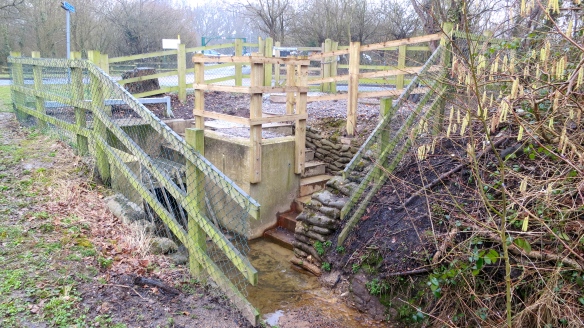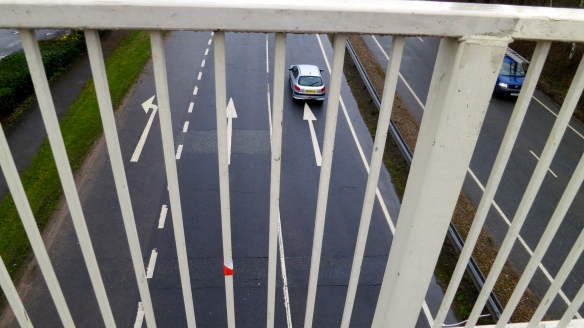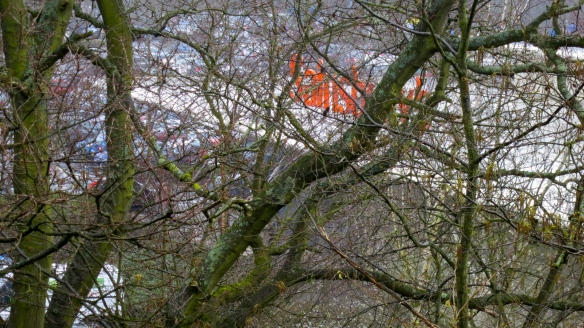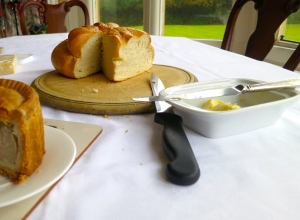It is becoming more difficult to summon up the enthusiasm for a sloshy, muddy, tramp around waterlogged streets and footpaths. However, I managed it once again this morning. After problems on the A31 brought about several changes of plan and direction, Jackie drove us to Sainsbury’s at Hedge End. She went shopping and I went for a walk. As I struggled along Tollbar Way it was the rain that did the driving. The headwind and other conditions were very similar to the first time I ran the Leicester marathon in 1983. This had me thinking of the very kind woman I never met who had sponsored me for whatever charity I was running for on that occasion. She wrote me a letter complimenting me on my finishing time in such unpleasant blustery weather.
There are many similar roundabouts leading to the Hedge End Park. Coming away from there I crossed a major road and took a footpath alongside Hedge End Retail Park. These two shopping areas, as my post of 21st October last year makes clear, are definitely not to be confused. The path led along the backs of houses until it came to Goodalls Way in Hedge End. At this point a stream runs under the main road and continues through meadow and woodland on the other side.  There is a recently constructed elaborate set of steps in a reinforced embankment that seems to be going nowhere but to the bed of the stream. I can only imagine it is there to provide access to clear a passage under the road when the stream is filled with loose mud, gravel, and vegetation.
There is a recently constructed elaborate set of steps in a reinforced embankment that seems to be going nowhere but to the bed of the stream. I can only imagine it is there to provide access to clear a passage under the road when the stream is filled with loose mud, gravel, and vegetation.
Across the road lies Goodalls Meadows. A few minutes in there was enough. It was far too boggy. I walked along Goodalls Way and, at the far end of a side road, spotted a dog owner with her pet, entering the wooded area. I followed. This was a nature reserve that was even too wet for ducks. The woman told me of a good gravel path that would take me back, eventually, to Sainsbury’s. She then told Barney, her lurcher, that he’d had enough for today and they were going back. Along the ensuing path there were a couple of signs directing walkers to a footbridge to the superstore. This had to be Sainsbury’s, which helped me know I had followed directions reasonably well. The footbridge wasn’t over the stream.  It was a massive construction spanning the motorway and leading directly to the car park. Had I known that I wouldn’t have ignored it in the past, and would have been saved my battle with the headwind. I took the bridge, and was grateful that the railings were high enough to prevent me from either being blown or jumping off it.
It was a massive construction spanning the motorway and leading directly to the car park. Had I known that I wouldn’t have ignored it in the past, and would have been saved my battle with the headwind. I took the bridge, and was grateful that the railings were high enough to prevent me from either being blown or jumping off it.
 The logo of this huge store is so distinctive and brightly coloured that it was clearly visible from my perch through the bare branches of substantial trees. This had me reflecting on how much this concern had grown and developed from the High Street grocers of my boyhood. Then, assistants in aprons stood behind a counter stocked with goods. They used a mechanical till. Tins and jars were on the shelves behind them. Fresh cured meat was sliced in front of you and wrapped in greaseproof paper. I don’t remember cling film. Cheese was cut from a block with a wire. You could buy just the quantity you wanted, not a whole bagful, and BOGOF had not been invented. In immediate postwar days the amount of each item you could purchase was rationed. Each household had a ration book and had to hand over coupons from it with their cash. The penny that Holly found on 13th would have bought quite a few sweets if you had enough of that era’s stamps.
The logo of this huge store is so distinctive and brightly coloured that it was clearly visible from my perch through the bare branches of substantial trees. This had me reflecting on how much this concern had grown and developed from the High Street grocers of my boyhood. Then, assistants in aprons stood behind a counter stocked with goods. They used a mechanical till. Tins and jars were on the shelves behind them. Fresh cured meat was sliced in front of you and wrapped in greaseproof paper. I don’t remember cling film. Cheese was cut from a block with a wire. You could buy just the quantity you wanted, not a whole bagful, and BOGOF had not been invented. In immediate postwar days the amount of each item you could purchase was rationed. Each household had a ration book and had to hand over coupons from it with their cash. The penny that Holly found on 13th would have bought quite a few sweets if you had enough of that era’s stamps.
As arranged, I met Jackie in the store’s cafe, and once more stared at the misty spray from cars in front on the journey home. One of her purchases was a cottage loaf. For those who are not familiar with this type of bread, it looks rather like two different sized rounded pieces of dough, one on top of the other. It was a childhood favourite. When it came to slicing this for lunch, I had just cut a couple of sections from a Walker’s, greatly to be recommended, pork pie. Now, there are several schools of thought about how to slice a cottage loaf. Not being sure what Jackie’s preferred option was, I asked her if she subscribed to the view that the smaller, top, section should be removed and tackled first. She was incredulous at the idea, and said she wanted a slice, not a chunk. Well, if you cut a slice from the loaf as a whole, you only get a small one because it doesn’t reach the smaller, top piece. When you reach the top section, it is likely to fall off from the first two or three cuts, because the join is so thin, so you in fact get two slices.
 So you can see, I was a bit discombobulated. And I’d just taken a wedge of pork pie. This must have been in my subconscious, because I attacked this rounded loaf in the same way as Jackie had her chocolate cake yesterday. And anyway, what she had served was a slice of cake, wasn’t it? I proudly produced a small but perfectly formed wedge of bread. She didn’t think it was a slice. So I then cut a bit off the crusty side. The result was a kind of zigzag assault. The reason Jackie hadn’t wanted to take the top off was that she didn’t want the opened part to dry out. I think I rather defeated the object. In fairness to me, the division between top and bottom sections is usually more marked than this one was. What would you do?
So you can see, I was a bit discombobulated. And I’d just taken a wedge of pork pie. This must have been in my subconscious, because I attacked this rounded loaf in the same way as Jackie had her chocolate cake yesterday. And anyway, what she had served was a slice of cake, wasn’t it? I proudly produced a small but perfectly formed wedge of bread. She didn’t think it was a slice. So I then cut a bit off the crusty side. The result was a kind of zigzag assault. The reason Jackie hadn’t wanted to take the top off was that she didn’t want the opened part to dry out. I think I rather defeated the object. In fairness to me, the division between top and bottom sections is usually more marked than this one was. What would you do?
Opting for safety, Jackie served up slices of a farmhouse loaf with our oven fish and chips this evening. We drank Latitude 35 degrees S chardonnay/semillon 2010 with this.

One comment